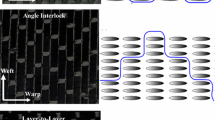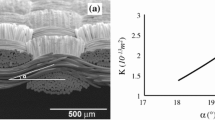Abstract
Three-dimensional (3D) woven textiles, including orthogonal and angle-interlock woven fabrics, exhibit high inter-laminar strength in addition to good in-plane mechanical properties and are particularly suitable for lightweight structural applications. Resin transfer moulding (RTM) is a cost-effective manufacturing process for composites with 3D-woven reinforcement. With increasing preform thickness, the influence of through-thickness permeability on RTM processing of composites becomes increasingly significant. This study proposes an analytical model for prediction of the through-thickness permeability, based on Poiseuille’s law for hydraulic ducts approximating realistic flow channel geometries in woven fabrics. The model is applied to four 3D-woven fabrics and three 2D-woven fabrics. The geometrical parameters of the fabrics were characterized by employing optical microscopy. For validation, the through-thickness permeability was determined experimentally. The equivalent permeability of inter-yarn gaps was found to account for approximately 90 % of the through-thickness permeability for the analysed fabrics. The analytical predictions agree well with the experimental data of the seven fabrics.






Similar content being viewed by others
References
Mallick PK (2007) Fiber-reinforced composites: materials, manufacturing, and design, 3rd edn. Taylor & Francis Group, Boca Raton
Krukenberg T, Paton R (1999) Resin transfer molding for aerospace structures. Kluwer Academic Publishers, Netherlands
Long A (2005) Design and manufacture of textile composites. Woodhead Publishing Limited, Cambridge
Greene DL (1992) Energy-efficiency improvement potential of commercial aircraft. Ann Rev Energy Environ 17:537–573
Zeng X, Brown LP, Endruweit A, Matveev M, Long AC (2014) Geometrical modelling of 3D-woven reinforcements for polymer composites: prediction of fabric permeability and composite mechanical properties. Compos A Appl Sci Manuf 56:150–160
Hickey CMD, Bickerton S (2013) Cure kinetics and rheology characterization and modelling of ambient temperature curing epoxy resins for resin infusion/VARTM and wet layup application. J Mater Sci 48(2):690–701. doi:10.1007/s10853-012-6781-8
Endruweit A, Glover P, Head K, Long AC (2011) Mapping of the fluid distribution in impregnated reinforcement textiles using Magnetic Resonance Imaging: application and discussion. Compos Part A Appl Sci Manuf 42(10):1369–1379
Grujicic M, Chittajallu KM, Shawn W (2006) Lattice Boltzmann method based computation of the permeability of the orthogonal plain-weave fabric preforms. J Mater Sci 41(23):7989–8000. doi:10.1007/s10853-006-0864-3
Mei CC, Vernescu B (2010) Homogenization methods for multiscale mechanics. World Scientific, Singapore, p 330
Mogavero J, Advani SG (1997) Experimental investigation of flow through multi-layered preforms. Polym Compos 18(5):649–655
Endruweit A, Long AC (2010) Analysis of compressibility and permeability of selected 3D-woven reinforcements. J Compos Mater 44(24):2833–2862
Desplentere F, Lomov SV, Woerdeman DL, Verpoest I, Wevers M, Bogdanovich A (2005) Micro-CT characterization of variability in 3D textile architecture. Compos Sci Technol 65(13):1920–1930
Badel P, Vidal-Salle E, Maire E, Boisse P (2008) Simulation and tomography analysis of textile composite reinforcement deformation at the mesoscopic scale. Compos Sci Technol 68(12):2433–2440
Mahadik Y, Brown KAR, Hallett SR (2010) Characterization of 3D-woven composite internal architecture and effect of compaction. Compos Part A Appl Sci Manuf 41(7):872–880
Awal A, Ghosh SB, Sain M (2009) Development and morphological characterization of wood pulp reinforced biocomposite fibers. J Mater Sci 44(11):2876–2881. doi:10.1007/s10853-009-3380-4
Karahan M, Lomov SV, Bogdanovich AE, Mungalov D, Verpoest I (2010) Internal geometry evaluation of non-crimp 3D orthogonal woven carbon fabric composite. Compos A Appl Sci Manuf 41(9):1301–1311
Rocha RPA, Cruz ME (2010) Calculation of the permeability and apparent permeability of three-dimensional porous media. Transp Porous Media 83(2):349–373
Gebart BR (1992) Permeability of unidirectional reinforcements for RTM. J Compos Mater 26(8):1101–1133
Cai Z, Berdichevesky AL (1993) An improved self-consistent method for estimating the permeability of a fiber assembly. Polym Compos 14(4):314–323
Bruschke MV, Advani SG (1993) Flow of generalized Newtonian fluids across a periodic array of cylinders. J Rheol 37(3):479–497
Xiao X, Long A, Zeng X (2014) Through-thickness permeability modelling of woven fabric under out-of-plane deformation. J Mater Sci 49(21):7563–7574. doi:10.1007/s10853-014-8465-z
Xiao X, Zeng X, Long AC, Cliford MJ, Lin H, Saldaeva E (2012) An analytical model for through-thickness permeability of woven fabric. Text Res J 82(5):492–501
Zupin Z, Hladnik A, Dimitrovski K (2012) Prediction of one-layer woven fabrics air permeability using porosity parameters. Text Res J 82(2):117–128
Mehaute B (1976) An introduction to hydrodynamics and water waves. Springer-Verlag, New York, p 16–22
Sutera SP, Skalak R (1993) The history of Poiseuille’s law. Annu Rev Fluid Mech 25:1–19
Advani SG, Bruschke MV, Parnas RS (1994) Resin transfer molding flow phenomena in polymeric composites, In ‘Flow and rheology in polymer composites manufacturing’. Elsevier science B. V, Amsterdam, p 56–78
Schlichting H, Gersten K (c2000) Boundary-layer theory. 8th edn, Springer, Berlin
Batchelor GK (c1967) An introduction to fluid dynamics. Cambridge University Press, Cambridge
Papautsky I, Gale BK, Mohanty S, Ameel TA, Frazier AB (1999) Effects of rectangular microchannel aspect ratio on laminar friction constant. Proceedings of the Society of Photo-Optical Instrumentation Engineers (SPIE), 3877: 147–158
Acknowledgements
The work was supported in part by the projects: RGC No.: 5158/13E and NSFC funding Grant No. 51373147 and Project code: JC201104210132A.
Author information
Authors and Affiliations
Corresponding authors
Appendix
Appendix
The frictional pressure loss in flow along a duct with arbitrary cross section, e.g. the duct formed by interwoven yarns, is usually expressed in terms of a friction factor \( \xi \) (also called a resistance coefficient) which is defined as [27]
where \( \Delta P \) and L are the pressure loss and the length of flow channel, D h is the hydraulic diameter as defined below, ρ is the density of the fluid and V is the mean velocity over the duct cross section. The hydraulic diameter is defined as four times the duct cross-sectional area A′ divided by the wetted perimeter O
For a circular tube, D h is equivalent to its geometrical diameter. The friction factor can be derived analytically for many cross sections (circular, triangular, quadratic, etc.) in laminar flows [18, 28] and can be expressed as
where c’ is a dimensionless shape factor and μ is the fluid viscosity. Then Eqs. a1 and a3 give
Comparing Eq. 1 with Eq. a4 gives
The Hagen–Poiseuille equation describes a laminar fluid flow along a circular tube (diameter D h), which has a relationship of pressure gradient and flow velocity
Comparison of Eqs. a6 and 1 gives the equivalent permeability of a circular tube
This implies that the value of c’ is 64.
When converting ducts with arbitrary rectangular cross section to virtual ducts with circular cross section, friction constants reported in the literature [29] for rectangular ducts with different width/length ratios, α, were divided by c’ to obtain c as listed in Table 3. These values can be fitted with a polynomial (coefficient of correlation R 2 = 1):
According to Eq. a8, the value of c can be obtained for calculation of K g for arbitrary gap length and width ratios, as demonstrated for the seven fabrics in Table 3.
Rights and permissions
About this article
Cite this article
Xiao, X., Endruweit, A., Zeng, X. et al. Through-thickness permeability study of orthogonal and angle-interlock woven fabrics. J Mater Sci 50, 1257–1266 (2015). https://doi.org/10.1007/s10853-014-8683-4
Received:
Accepted:
Published:
Issue Date:
DOI: https://doi.org/10.1007/s10853-014-8683-4




